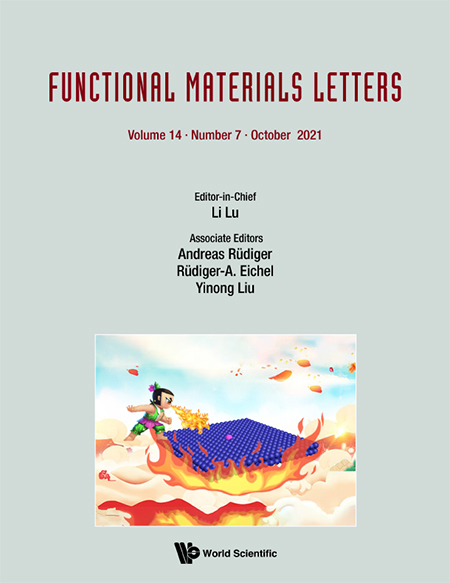Review on bimetallic catalysts for electrocatalytic denitrification
Abstract
Accelerated industrialization disrupts the global nitrogen cycle, resulting in alarmingly increased nitrate in groundwater and other water bodies. Electrocatalytic nitrate reduction (NO3RR) with high automation can effectively remove nitrate from polluted water, thus avoiding nitrate accumulation. However, the sluggish cathode reaction kinetics severely hampered the efficiency of NO3RR. Developing high-performance cathode catalysts is of great significance for boosting NO3RR. Compared with pure metal catalysts, bimetal catalysts can further improve the cathode activity and selectivity to nitrogen or ammonia in the electrocatalytic process, attracting extensive research interest. In this review, we discussed the background of denitrification requirements and the development status of bimetallic denitrification catalyst. Metallic cathode catalysts, such as noble-metal, 3d transition metal, main group metal, are described emphatically. Finally, present challenges and future outlook on bimetallic denitrification catalysts are depicted.
References
- 1. , Chem. Eng. J. 279, 372 (2015). Crossref, ISI, Google Scholar
- 2. , Environ. Earth Sci. 77, 551 (2018). Crossref, ISI, Google Scholar
- 3. , J. Am. Water Works Assoc. 109, 44 (2017). Crossref, ISI, Google Scholar
- 4. , Electrochim. Acta 144, 341 (2014). Crossref, ISI, Google Scholar
- 5. , Environ. Sci. Pollut. Res. 22, 9575 (2015). Crossref, ISI, Google Scholar
- 6. , Sep. Purif. Technol. 222, 85 (2019). Crossref, ISI, Google Scholar
- 7. , Appl. Surf. Sci. 478, 539 (2019). Crossref, ISI, Google Scholar
- 8. , Petrol. Sci. Technol. 36, 2143 (2018). Crossref, ISI, Google Scholar
- 9. , J. Mater. Chem. A 8, 16920 (2020). Crossref, Google Scholar
- 10. , Vacuum 193, 110537 (2021). Crossref, ISI, Google Scholar
- 11. , Nano Today 40, 101245 (2021). Crossref, ISI, Google Scholar
- 12. , Angew. Chem., Int. Ed. 57, 10187 (2018). Crossref, ISI, Google Scholar
- 13. , Electrochim. Acta 53, 5977 (2008). Crossref, ISI, Google Scholar
- 14. , J. Hazard. Mater. 192, 507 (2011). Crossref, ISI, Google Scholar
- 15. , Electrochim. Acta 71, 270 (2012). Crossref, ISI, Google Scholar
- 16. , Electrochim. Acta 52, 6412 (2007). Crossref, ISI, Google Scholar
- 17. , Appl. Catal. B, Environ. 66, 40 (2006). Crossref, ISI, Google Scholar
- 18. , Appl. Catal. A, Gen. 564, 26 (2018). Crossref, ISI, Google Scholar
- 19. , Nanomaterials (Basel) 11, 195 (2021). Crossref, ISI, Google Scholar
- 20. , Electrochim. Acta 50, 4318 (2004). Crossref, ISI, Google Scholar
- 21. , Natl. Sci. Rev. 8, nwaa088 (2021). Crossref, ISI, Google Scholar
- 22. , Appl. Catal. A, Gen. 478, 259 (2014). Crossref, ISI, Google Scholar
- 23. , J. Catal. 198, 309 (2001). Crossref, ISI, Google Scholar
- 24. , Phys. Chem. Chem. Phys. 15, 3196 (2013). Crossref, ISI, Google Scholar
- 25. , Water Res. 137, 28 (2018). Crossref, ISI, Google Scholar
- 26. , J. Electroanal. Chem. 622, 64 (2008). Crossref, ISI, Google Scholar
- 27. , Electrochem. Commun. 110, 106607 (2020). Crossref, ISI, Google Scholar
- 28. , J. Environ. Sci. Health, A 56, 501 (2021). Crossref, ISI, Google Scholar
- 29. , Angew. Chem., Int. Ed. 59, 1975 (2020). Crossref, ISI, Google Scholar
- 30. , J. Am. Chem. Soc. 129, 10171 (2007). Crossref, ISI, Google Scholar
- 31. , Appl. Catal. B, Environ. 273, 119053 (2020). Crossref, ISI, Google Scholar
- 32. , Electrochem. Commun. 25, 91 (2012). Crossref, ISI, Google Scholar
- 33. , Appl. Catal. B, Environ. 91, 441 (2009). Crossref, ISI, Google Scholar
- 34. , Chem. Eng. J. 416, 129074 (2021). Crossref, ISI, Google Scholar
- 35. , J. Mater. Chem. A 8, 9545 (2020). Crossref, Google Scholar
- 36. , J. Appl. Electrochem. 35, 1203 (2005). Crossref, ISI, Google Scholar
- 37. , J. Alloy Compd. 432, 323 (2007). Crossref, ISI, Google Scholar
- 38. , J. Am. Chem. Soc. 142, 5702 (2020). Crossref, ISI, Google Scholar
- 39. , Appl. Catal. A, Gen. 297, 24 (2006). Crossref, ISI, Google Scholar
- 40. , J. Chem. Technol. Biotechnol. 91, 212 (2016). Crossref, ISI, Google Scholar
- 41. , Environ. Technol. 38, 3055 (2017). Crossref, ISI, Google Scholar
- 42. , Desalin Water Treat. 57, 19025 (2016). Crossref, ISI, Google Scholar
- 43. , Nano Res. 13, 3157 (2020). Crossref, ISI, Google Scholar
- 44. , ACS Catal. 9, 7052 (2019). Crossref, ISI, Google Scholar
- 45. , Water Res. 173, 115596 (2020). Crossref, ISI, Google Scholar
- 46. , Nanoscale 13, 10108 (2021). Crossref, ISI, Google Scholar
- 47. , Catal. Today 328, 300 (2019). Crossref, ISI, Google Scholar
- 48. , ChemElectroChem 1, 172 (2014). Crossref, ISI, Google Scholar
- 49. , J. Electroanal. Chem. 629, 110 (2009). Crossref, ISI, Google Scholar
- 50. , Environ. Res. 201, 111577 (2021). Crossref, ISI, Google Scholar
- 51. , Appl. Catal. A, Gen. 425, 145 (2012). Crossref, ISI, Google Scholar
- 52. , Electrochim. Acta 340, 135914 (2020). Crossref, ISI, Google Scholar
- 53. , Appl. Catal. B, Environ. 285, 119784 (2021). Crossref, ISI, Google Scholar
- 54. , J. Electroanal. Chem. 599, 167 (2007). Crossref, ISI, Google Scholar
- 55. , Chem. Eng. J. 159, 203 (2010). Crossref, ISI, Google Scholar
| Remember to check out the Most Cited Articles! |
|---|
|
Check out New Titles in Materials Science and Nanotechnology |


